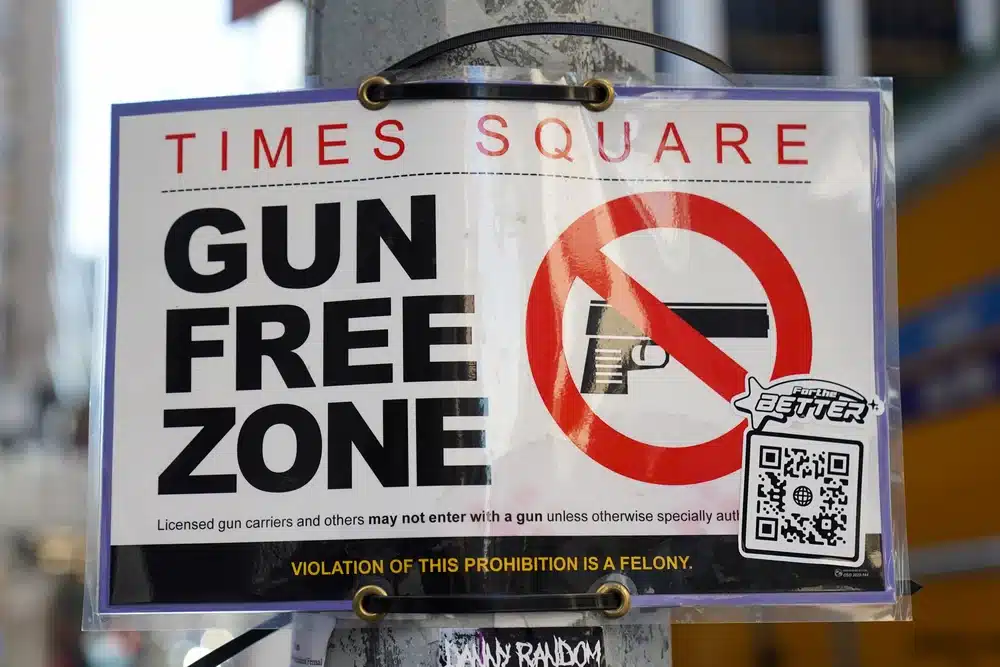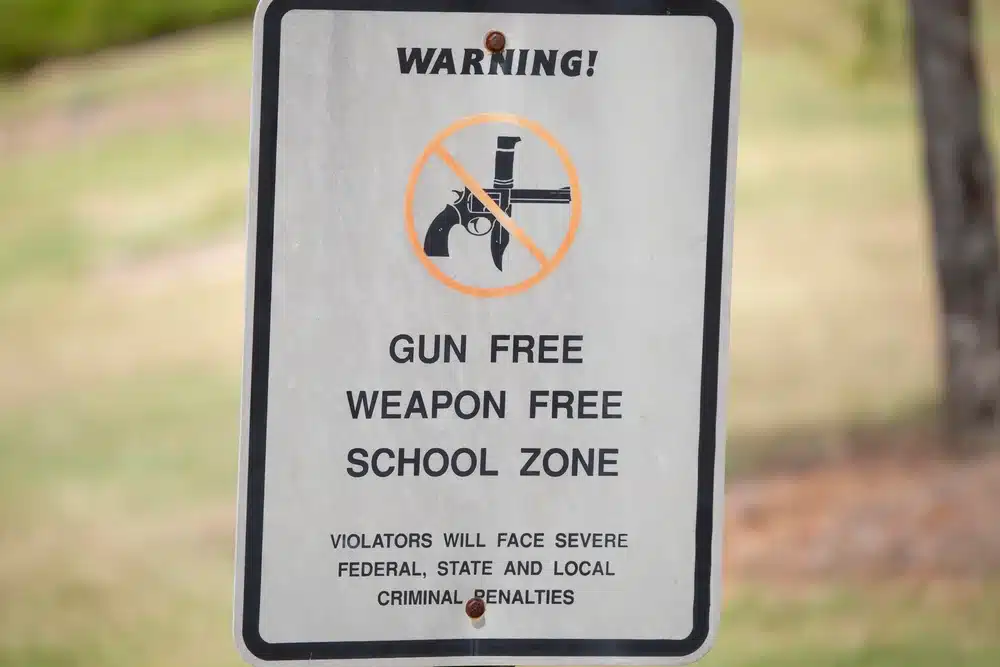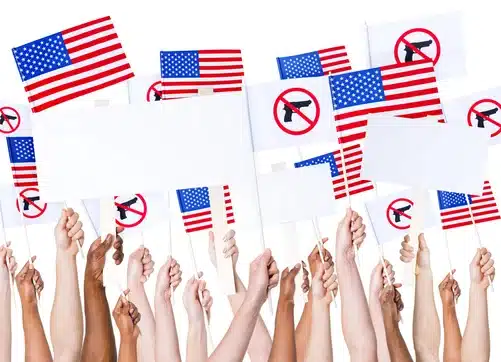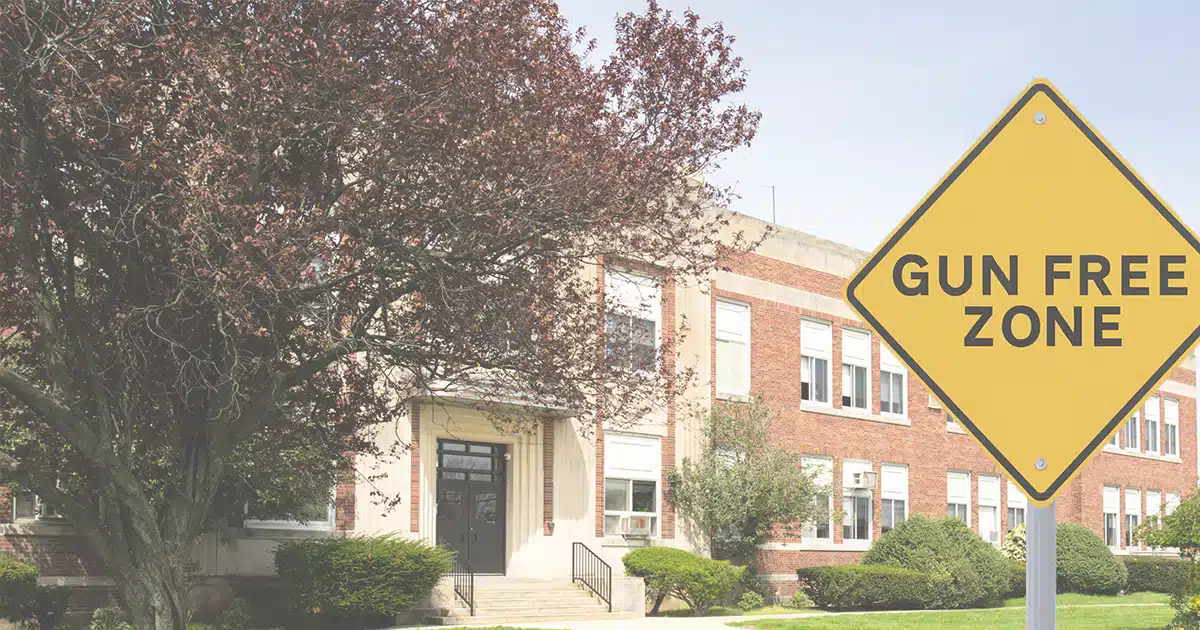With an average of 112 deaths each day in the U.S. due to gun violence, the question of whether gun-free zones and gun laws can enhance public safety is a widely discussed topic. In this article, we’ll look at what gun free zones entail, including their legal frameworks and real-world implications in schools, businesses and private property. We’ll also examine both federal and state laws on gun free zones, the policies of the companies that ban guns, the debates around their effectiveness, and the legal consequences of breaking the rules.
Key Points:
- Gun free zones are areas where firearms are prohibited, but the definition and laws vary by state.
- Proponents claim gun free zones enhance public safety by deterring violent crime, while critics say they attract attackers because there’s no one to shoot back.
- It’s important to understand the rules and regulations around gun-free zones because the legal penalties for breaking these laws can be severe, including felony charges and large fines.

What is a Gun Free Zone?
A gun-free zone is defined as a specific location or parameter that strictly prohibits the carrying of firearms to reduce public safety risks. These often include educational institutions, government buildings such as courthouses and city halls, and specific private property. By setting up a gun free zone, the expectation is that it will create spaces less prone to firearm dangers. Federally imposed regulations enforce this by preventing most people from carrying arms in these restricted areas.
Understanding what constitutes a gun free zone helps us understand the legal parameters set for them and how their place in the broader social constructs can increase overall security.
Legal Definition and Scope
To navigate gun-free zones without breaking the law requires knowledge of both federal and state laws regarding gun-free zones. There is no standardized legal definition of gun-free zones in the U.S., which means that associated laws vary from state to state. This has created inconsistencies with how to set up, manage, and enforce these zones. For example, some states allow firearms on school property under certain conditions, while others ban them outright. And according to the federal government, it’s illegal to carry a firearm within 1,000 feet of a school unless you have a relevant state license – and students caught with a gun on school property are automatically expelled under the Gun Free Schools Act.
In many states, such as Texas, there are severe penalties for carrying firearms in designated restricted areas such as school grounds and government buildings. For example, Texas Penal Code 46.035 specifies exactly where it is illegal to carry weapons and emphasizes the importance of knowing the rules.
Federal vs. State Laws
In 1994, Congress introduced the Gun-Free Schools Act, which encouraged each state receiving federal education funds to implement its own laws, now commonly referred to as zero-tolerance laws. This act requires each state receiving federal funds to have a state law in effect requiring local educational agencies to expel, for at least one year, any student who is determined to have brought a weapon to school.
The Gun Free Schools Act sets national criteria for gun free zones, but each state controls their own areas. This shared jurisdiction can lead to inconsistencies and uneven enforcement since state laws on gun free zones can be challenged or changed through new legislation or public opinion.
One example is the federal law prohibiting anyone from carrying a firearm within 1,000 feet of a school zone. This law conflicts with a Texas law that allows qualified individuals with a permit to carry concealed weapons under certain circumstances.
The interaction between federal and state laws highlights the complexity of following the rules around gun-free zones. For instance, the first Gun Free School Zones Act of 1990 was challenged in the Supreme Court in a case known as the United States v. Lopez. In this case, it was argued that the possession of firearms in school zones was directly related to interstate commerce since all firearms were moved in interstate commerce at some point. This case emphasized the role of the Commerce Clause in federal regulations and how the possession of firearms in school zones affects interstate commerce.
It’s important for gun owners to stay up to date on both federal and state laws so they can comply and avoid legal trouble. These rules are not only to define what’s legal, but also to help citizens make informed decisions about carrying concealed firearms in designated gun-free school zones.
Gun-Free School Zones

Federal laws such as the 1990 Gun Free School Zones Act and the 1994 Gun-Free Schools Act prohibit the carrying of firearms to increase safety. The Act restricts carrying guns within or near educational facilities, including public, private, and parochial elementary schools. These laws aim to create a safe learning environment by limiting access to firearms on school premises, but it does not override the school’s duty of care responsibilities. The goal behind establishing schools as gun-free zones is to ultimately reduce firearm violence and create a safe environment for both students and teachers. From primary to secondary education, these safety measures are crucial in developing procedures that maintain security in academic settings.
However, there is still much debate and discussion on how effective these gun free zones are in actual school safety.
Elementary and Secondary Education
Establishing gun-free zones in schools is key to a safe and supportive learning environment. While guns are banned in K-12 schools in many states, there are exceptions where teachers can carry firearms if they meet certain conditions. In fact, there are at least nine states that allow teachers with concealed carry permits to have guns on school property, reflecting different views on how to best protect students and employees.
There are also exemptions to the ban on carrying firearms within academic institutions. This includes situations involving armed security officers and programs teaching hunting skills. These provisions aim to strike a balance between upholding safety protocols while accommodating necessary exceptions such as allowing licensed individuals and security personnel to possess weapons.
Impact on School Safety
The effectiveness of gun-free school zones is a contentious issue with some claiming that they improve safety, while others believe they may create more risk. Proponents argue that gun-free zones reduce violent offenses, self-harm, and mass casualty events by prohibiting firearms on school property. And by enacting firearm restrictions in these zones, schools can create more secure learning environments.
Because there is inconclusive research and differing views on gun-free zones, this topic is often discussed in school safety conversations. A closer examination of the effectiveness of these policies can help us understand their importance in protecting educators and students.
Private Property and Business Policies
Private property owners and businesses are allowed to create gun-free zones on their premises. For example, in Texas, by posting proper notice to visitors, property owners can declare their space as areas where firearms are prohibited. This allows them to tailor their individual environments according to their unique safety concerns and business principles with regards to gun violence. Once established, a gun-free zone prohibits private entities from allowing firearms on their property. It can also impact customer perception and engagement with these businesses. Some people may feel safer knowing weapons are now allowed, while others may feel more vulnerable.
Business Policies on Firearms
Companies can decide their own policy on whether firearms are allowed within their premises. This can include either open carry or concealed carry, and usually mirrors the company’s brand values and customer safety concerns. For example, companies such as Starbucks and Target have implemented firearm policies to improve customer safety in line with their corporate image.
Deciding to make an area gun-free has implications on how customers view the business. It’s important for a business to understand that this can attract or repel different segments of customers depending on individual views on gun ownership and security issues.
Enforcement and Compliance
It’s up to individual property owners to make it clear that firearms are not allowed by posting conspicuous signage that bans guns. Private property owners can prohibit guns on their property regardless of whether individuals have a license for their weapons.
Depending on the type of business, there may also be specific signs required by law to effectively enforce a no-gun policy within these establishments. Additional security measures and policies, such as bag checks or increased security personnel, may also complement these gun-free zones.
Public Opinion and Debate
There is much debate on gun-free zones with public opinion being highly polarized. In how effective and necessary these areas are in preventing gun violence. Those who support them argue that by removing guns from certain areas, safety is improved because it reduces the likelihood of gun-related violent incidents. Opponents say just the opposite and claim that such spaces might inadvertently become targets for active shooters because there is no armed protection onsite.
Studies such as those conducted by RAND aim to dissect the impact of policies related to gun-free zones on various outcomes in the United States. For example, one study evaluated the relationship between violent crime on college campuses and campus-carry laws, which explicitly allow the carrying of concealed firearms by students, faculty, and other staff. Unfortunately, the results of this and other studies continue to be inconclusive on the effectiveness of gun free zones. However, even with the lack of evidence, it is important for the public to continue engaging in this conversation so that future legislation can address concerns of both proponents and opponents of gun free zones.
Arguments For Gun Free Zones
Recent studies show that gun-free zones might actually deter certain types of violent crime. Proponents argue that establishing such zones helps create a safer environment by reducing the likelihood of gun-related violent incidents. They say these zones prevent accidental firearm discharges by limiting the presence of guns in certain areas.

Studies also indicate that removing guns from specific locations can contribute to better mental health and overall community well-being. That is why companies such as Starbucks and Target often implement policies on firearms to secure their customers and uphold their brand image. By creating gun-free spaces, these businesses aim to create an environment where safety and customer satisfaction come first, and this brand image makes their customers feel better protected.
Arguments Against Gun Free Zones
Opponents of gun-free zones claim that these areas might attract active shooters because they know they will not have any armed opposition at that location. In fact, research has shown that 97.8% of mass shootings occur in areas where guns are prohibited. This statistic may support the claim that shooters prefer to target areas with no immediate threat to them.
The debates for and against gun-free zones highlight the need for a balanced view that weighs their effectiveness in promoting safety against their potential to create environments where mass shooters can find defenseless targets. While some say more guns mean less crime, especially in gun-free zones, various studies show insufficient evidence to support this claim. In fact, research on gun-free zones and their impact on gun violence and mass shootings has yielded mixed results, and whether they work is still up for debate.
Mixed Results
With no conclusive evidence pointing to whether gun-free zones help prevent or promote gun violence, the debate among academics and policymakers continues. This lack of clear evidence points to the need to understand the appropriate research and in-depth study to determine the actual impact of gun-free zones. It will be important that these projects consider multiple factors when evaluating the pros and cons of gun-free zones, including the legal standard of reasonable cause under the Gun-Free School Zones Act of 1990.
Real-Life Examples
Looking at real-life scenarios can help us understand how gun-free zones affect public safety. For example, in 2012, the Bureau of Alcohol, Tobacco, Firearms and Explosives (ATF) told the town of Stratham, New Hampshire, that hunting on public land within 1,000 feet of a school would violate the Gun-Free School Zones Act. Other research shows a correlation between the passage of concealed carry laws and an 8% increase in aggravated assault incidents, which raises questions about the benefits of allowing concealed weapons in areas that were previously gun-free.
Even well-trained law enforcement officers are not immune to assaults by armed individuals, which challenges the idea that gun-free zones prevent violence. Uncertainty remains on how campus carry laws impact violent crime rates, so more research is needed to understand their true effect.
These real-life scenarios show the complexities and challenges of implementing and enforcing gun-free zones. A person with a firearm must follow certain rules, and they need to be aware of the legal consequences of not following those rules.
Legal Consequences
Individuals who do not follow gun-free zone laws face severe legal penalties at the state and federal levels, including felony charges and hefty fines. Due to these potential outcomes, it is crucial to understand and follow these rules. In Texas, for example, infractions of these laws can result in felony charges, with penalties up to two years in jail and $10,000 in fines. The exact penalties will depend on the circumstances of the violation and the type of firearm involved.
Also in Texas, if someone brings a firearm into a designated gun-free zone, they could be charged with criminal trespassing, which is a felony. In these types of cases, the attorney general plays a big role in interpreting these laws and enforcing them. This is another reason it’s important for individuals who own or carry firearms to understand the penalties and harsh legal consequences so they can avoid both.
Role of Law Enforcement
Enforcing the rules in gun-free zones is the responsibility of law enforcement to protect the public. Detecting those who violate these rules is a big challenge, so it requires active participation and awareness from the community and authorities to keep these areas safe. According to a federal bureau report on active shootings, the effectiveness of armed civilians in stopping mass shootings is rare, so law enforcement is key in these situations. To keep gun-free zone laws intact, local authorities and citizens must work together. This partnership can strengthen security and ensure these free zones actually work in reducing gun violence and keeping people safe.
How Gun Detection Plays an Important Role in Gun Free Zones
Since the essence of a gun free zone is to prohibit the presence of firearms, organizations often rely on preventative technologies and procedures to help ensure the law is obeyed. This may include metal detectors that can alert authorities to weapons hidden in bags or jackets, or even the manual inspection of personal items and backpacks.
Another strategy is visual AI gun detection, such as Omnilert Gun Detect, which has become a key layer of protection in an organization’s overall security infrastructure. Once installed in an existing security camera, this technology can identify a weapon in a fraction of a second and, once verified, can instantly activate a response that includes dispatching police, locking doors, sounding alarms, and automating other responses to notify those in harm’s way and save lives. This technology is being widely adopted across the U.S. with the goal that over time, it will become as ubiquitous as fire alarms in public places.
During an active shooting incident, research has proven that a fast response with actionable intelligence is what changes outcomes in terms of whether lives are lost or saved. With technologies such as visual AI gun detection deployed, places that are designed to be gun-free zones can be monitored to ensure they remain just that, and if a weapon manages to make its way in, the danger can be quickly mitigated.
How to Navigate Gun Free Zones
To effectively navigate gun-free zones, gun owners must have a deep understanding of the local laws and regulations. Staying updated on area-specific restrictions, especially in public areas such as schools and government buildings, is key to following the rules and avoiding legal trouble.
This section offers tips on how gun owners can behave within these restricted areas.
Check Local Laws
Gun owners must continually educate themselves on the gun-free zone laws at the local and state levels. Not staying current with these laws, especially with Supreme Court decisions such as the case of the United States v. Lopez and New York State Rifle and Pistol Association, Inc. v. Bruen, can result to unintentional violations and legal problems.
It’s also essential to monitor updates in laws, on both a state and federal level, to ensure you are complying with the most recent regulations.
Gun Free Zones – Help or Hindrance?
Individuals and businesses must research, stay informed, and comply with the federal and state laws around gun-free zones that impact their region. The debate on whether gun-free zones offer protection or create more risks will likely continue for the near future. Each side has its own set of arguments, but at the end of the day, they both agree that keeping the public safe from gun violence is the paramount concern, and that is a goal everyone can help work towards.
FAQs
What is a gun-free zone?
A gun-free zone is an area where firearms are not allowed to improve public safety and reduce gun violence.
What are the legal consequences of violating gun-free zone laws?
Disregarding laws on gun-free zones can result in serious legal troubles, including felony charges, imprisonment, and hefty fines if an individual knowingly violates these laws.
You must comply with these rules to avoid such severe consequences.
How do businesses enforce gun-free zones?
Businesses enforce gun-free zones by displaying signage that indicates firearm restrictions and may also conduct bag checks to ensure compliance. These measures keep the environment safe for all patrons.
Are there any exceptions to gun-free zone laws in schools?
Yes, there are exceptions to gun-free zone laws in schools, which include armed security personnel and, in some states, teachers with concealed-carry permits. Federal facilities are also designated as gun-free zones to maintain order and safety, illustrating the legal framework that restricts firearm possession in these areas.
How can gun owners check local gun-free zone laws?
Gun owners can stay informed about local gun-free zone laws by regularly reviewing local and state laws and monitoring legislative changes. It is also advisable to continually monitor these laws for any updates that may change what is allowed or prohibited, or even the consequences that may result from their violation.



